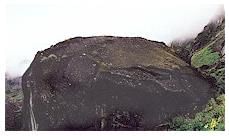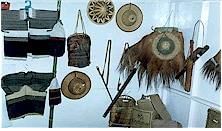Class 9 Exam > Class 9 Questions > What is meant by idu-mishmi dancers
Start Learning for Free
What is meant by idu-mishmi dancers
Verified Answer
What is meant by idu-mishmi dancers
The IDU-MISHMI is a major sub-tribe of Mishmi group. Their brethren tribes are namely the DIGARU-MISHMI (TARAONS) and the MIJU-MISHMI (KAMANS). They inhabit the Lohit district, Dibang Valley district and Lower Dibang Valley district. They are of mongoloid stock and speak the Tibeto-Burman language.
The Idu Mishmi is one of the two major tribes of the district. The Idu Mishmis can be distinctively identified among other tribal groups of Arunachal Pradesh by their typical hairstyle, distinctive costumes and artistic patterns embedded on their clothes. People of sober nature still maintain deep-rooted aesthetic values in their day-to-day life with great pride and honour. All pervading goddess Nani-Intaya is the sole creator of the universe for the Idus.

The Idus have their distinct dialect, which falls under the Tibeto-Burman group of languages. Traditionally, Idus believe in animism. They worship several benevolent and malevolent spirits. Nani-Intaya and Masello Zino are worshipped as creators of mankind and universe as a whole. Mythological characters like SINE-RU a first IGU (Idu Priest) still holds high place and reverence in the minds of the people. The prints of his palm on the huge rocks at Athu Popu near Keyala Pass in Dibang Valley district on China border, is supreme and holy shrine. The major festivals of the Idus are ‘Reh’ and ‘Ke-meh-ha’. Reh festival is held during the month of February. It is an occasion for people to relax, enjoy, dance, eat and drink.
The Idus are expert craftsman. The Idu women, in particular, are very good weavers. Their great aesthetic sense is well reflected in the exquisite designs created on the clothes produced on handlooms. The Idu men are well apt in making beautiful basketry items of bamboo and cane.


A well-developed civilization dated back in the pages of history can be found in the region. Remnants of 10th Century AD found at Bhismaknagar, Chidu & Chimri villages in the lower belt of the district prove that the Idus coexisted with great harmony with the people of plains and adjoining states.
 This question is part of UPSC exam. View all Class 9 courses
This question is part of UPSC exam. View all Class 9 courses
Most Upvoted Answer
What is meant by idu-mishmi dancers
Idu-Mishmi Dancers: Preserving Cultural Heritage through Dance
Introduction:
The Idu-Mishmi community is an indigenous group residing in the northeastern part of India, particularly in the Arunachal Pradesh state. They have a rich cultural heritage, which includes various art forms, traditional practices, and festivities. One of the prominent aspects of their culture is their unique dance forms, known as Idu-Mishmi dances. These dances not only serve as a means of entertainment but also play a significant role in preserving and showcasing their cultural identity.
Preservation of Cultural Heritage:
The Idu-Mishmi community takes immense pride in their cultural heritage and makes continuous efforts to preserve and promote it. Their dances are a significant part of this endeavor as they serve as a medium to pass down their traditions and values from one generation to another. By practicing and performing these dances, they ensure the longevity of their cultural identity.
Key Points:
1. Cultural Significance: Idu-Mishmi dances hold great cultural significance as they are performed during various occasions and festivals. They are an integral part of rituals, ceremonies, and celebrations, reflecting the community's spiritual beliefs and traditions.
2. Symbolism and Themes: Idu-Mishmi dances often incorporate symbolic gestures, movements, and themes that represent various aspects of their lives, such as nature, agricultural practices, hunting, and traditional stories. These elements make the dances not only visually appealing but also deeply meaningful.
3. Traditional Costumes and Accessories: The dancers adorn themselves in traditional attire and accessories, adding to the visual allure of the performance. Colorful garments, intricate jewelry, and headgears are commonly worn, reflecting the cultural aesthetics of the Idu-Mishmi community.
4. Musical Accompaniment: Idu-Mishmi dances are accompanied by traditional music, which includes instruments like drums, bamboo flutes, and wooden clappers. The rhythmic beats and melodies enhance the overall experience, creating a harmonious blend of movement and sound.
5. Dance Forms: There are several dance forms within the Idu-Mishmi tradition, each with its unique style and purpose. Some popular dances include the Ponung dance, the Chalo dance, and the Tapu dance. These dances vary in tempo, choreography, and the number of participants involved.
6. Community Participation: Idu-Mishmi dances are not limited to professional performers but are open to community participation. People of all ages, from children to the elderly, actively engage in learning and performing these dances, fostering a sense of unity, belonging, and cultural pride.
Conclusion:
Idu-Mishmi dancers play a crucial role in preserving and promoting the cultural heritage of the Idu-Mishmi community. Through their performances, they pass down traditional knowledge, values, and stories to younger generations, ensuring the continuity of their cultural identity. The vibrancy and uniqueness of Idu-Mishmi dances make them a captivating and visually appealing form of artistic expression. By cherishing and embracing their cultural heritage, the Idu-Mishmi community showcases the richness and diversity of India's indigenous traditions.
Introduction:
The Idu-Mishmi community is an indigenous group residing in the northeastern part of India, particularly in the Arunachal Pradesh state. They have a rich cultural heritage, which includes various art forms, traditional practices, and festivities. One of the prominent aspects of their culture is their unique dance forms, known as Idu-Mishmi dances. These dances not only serve as a means of entertainment but also play a significant role in preserving and showcasing their cultural identity.
Preservation of Cultural Heritage:
The Idu-Mishmi community takes immense pride in their cultural heritage and makes continuous efforts to preserve and promote it. Their dances are a significant part of this endeavor as they serve as a medium to pass down their traditions and values from one generation to another. By practicing and performing these dances, they ensure the longevity of their cultural identity.
Key Points:
1. Cultural Significance: Idu-Mishmi dances hold great cultural significance as they are performed during various occasions and festivals. They are an integral part of rituals, ceremonies, and celebrations, reflecting the community's spiritual beliefs and traditions.
2. Symbolism and Themes: Idu-Mishmi dances often incorporate symbolic gestures, movements, and themes that represent various aspects of their lives, such as nature, agricultural practices, hunting, and traditional stories. These elements make the dances not only visually appealing but also deeply meaningful.
3. Traditional Costumes and Accessories: The dancers adorn themselves in traditional attire and accessories, adding to the visual allure of the performance. Colorful garments, intricate jewelry, and headgears are commonly worn, reflecting the cultural aesthetics of the Idu-Mishmi community.
4. Musical Accompaniment: Idu-Mishmi dances are accompanied by traditional music, which includes instruments like drums, bamboo flutes, and wooden clappers. The rhythmic beats and melodies enhance the overall experience, creating a harmonious blend of movement and sound.
5. Dance Forms: There are several dance forms within the Idu-Mishmi tradition, each with its unique style and purpose. Some popular dances include the Ponung dance, the Chalo dance, and the Tapu dance. These dances vary in tempo, choreography, and the number of participants involved.
6. Community Participation: Idu-Mishmi dances are not limited to professional performers but are open to community participation. People of all ages, from children to the elderly, actively engage in learning and performing these dances, fostering a sense of unity, belonging, and cultural pride.
Conclusion:
Idu-Mishmi dancers play a crucial role in preserving and promoting the cultural heritage of the Idu-Mishmi community. Through their performances, they pass down traditional knowledge, values, and stories to younger generations, ensuring the continuity of their cultural identity. The vibrancy and uniqueness of Idu-Mishmi dances make them a captivating and visually appealing form of artistic expression. By cherishing and embracing their cultural heritage, the Idu-Mishmi community showcases the richness and diversity of India's indigenous traditions.

|
Explore Courses for Class 9 exam
|

|
Question Description
What is meant by idu-mishmi dancers for Class 9 2025 is part of Class 9 preparation. The Question and answers have been prepared according to the Class 9 exam syllabus. Information about What is meant by idu-mishmi dancers covers all topics & solutions for Class 9 2025 Exam. Find important definitions, questions, meanings, examples, exercises and tests below for What is meant by idu-mishmi dancers.
What is meant by idu-mishmi dancers for Class 9 2025 is part of Class 9 preparation. The Question and answers have been prepared according to the Class 9 exam syllabus. Information about What is meant by idu-mishmi dancers covers all topics & solutions for Class 9 2025 Exam. Find important definitions, questions, meanings, examples, exercises and tests below for What is meant by idu-mishmi dancers.
Solutions for What is meant by idu-mishmi dancers in English & in Hindi are available as part of our courses for Class 9.
Download more important topics, notes, lectures and mock test series for Class 9 Exam by signing up for free.
Here you can find the meaning of What is meant by idu-mishmi dancers defined & explained in the simplest way possible. Besides giving the explanation of
What is meant by idu-mishmi dancers, a detailed solution for What is meant by idu-mishmi dancers has been provided alongside types of What is meant by idu-mishmi dancers theory, EduRev gives you an
ample number of questions to practice What is meant by idu-mishmi dancers tests, examples and also practice Class 9 tests.

|
Explore Courses for Class 9 exam
|

|
Signup for Free!
Signup to see your scores go up within 7 days! Learn & Practice with 1000+ FREE Notes, Videos & Tests.


















